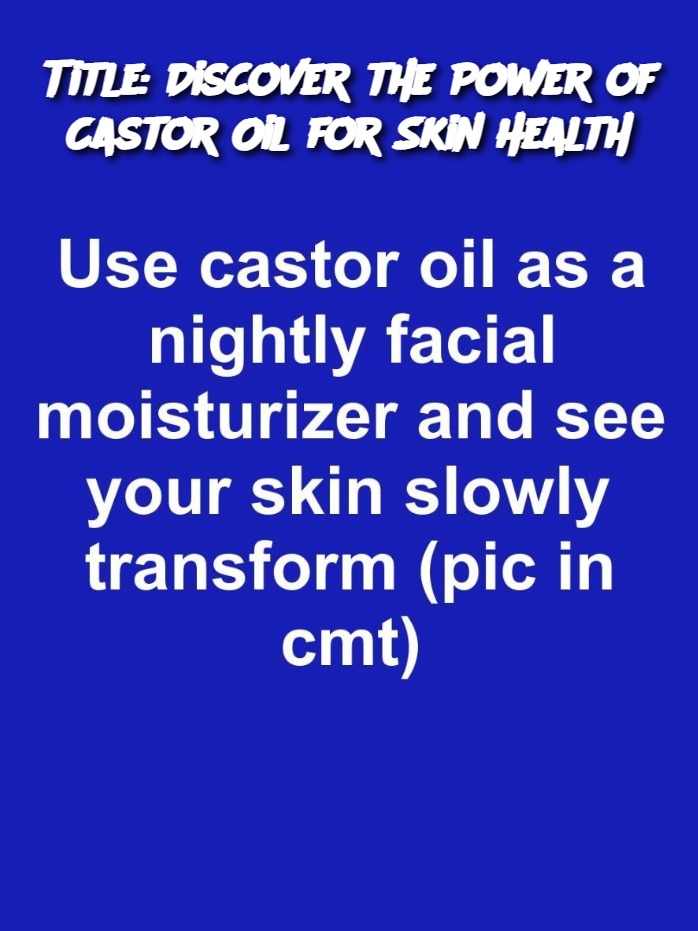- Castor Oil: The primary ingredient for all the benefits listed above. Pure, cold-pressed castor oil is best for skin use as it retains all the nutrients and healing properties.
- Essential Oils (Optional): You can mix castor oil with other essential oils like lavender or tea tree oil for added benefits, such as relaxation or enhanced antimicrobial properties.
- Aloe Vera Gel (Optional): Combining castor oil with aloe vera gel can create a soothing mix for dry or irritated skin.
Preparation:
-
Patch Test: Before using castor oil on your face or body, do a patch test on a small area of your skin to make sure you don’t have any allergic reactions.
-
Direct Application: For dry skin or acne, apply a few drops of castor oil directly to the affected area. Gently massage it into your skin for about 2-3 minutes to allow it to absorb. You can leave it on overnight for deeper hydration or healing.
-
DIY Skin Mask: For a hydrating face mask, mix castor oil with a teaspoon of honey or aloe vera gel. Apply the mixture to your face, leave it on for 15-20 minutes, then rinse with lukewarm water.
-
Body Lotion: You can also mix castor oil with your regular moisturizer to enhance its hydrating properties, especially for areas prone to dryness such as elbows, knees, and feet.
Serving and Storage Tips:
- Application Frequency: Depending on your skin needs, you can use castor oil daily for deep moisturization or a few times a week for acne treatment or scar reduction. Start with 2-3 applications per week and adjust as needed.
- Storage: Store castor oil in a cool, dark place away from direct sunlight to preserve its potency. Make sure the bottle is tightly sealed to prevent contamination.
Variants:
- For Sensitive Skin: If you have sensitive skin, you can dilute castor oil with a carrier oil like coconut oil or jojoba oil to make it gentler on your skin.
- For Acne-Prone Skin: Mix castor oil with a few drops of tea tree oil for an extra antimicrobial boost that will help keep acne at bay.
- For Dry Skin: Castor oil can be used as a stand-alone treatment or mixed with hydrating ingredients like honey or aloe vera for an intense moisturizing effect.
FAQ:
Q: Is castor oil suitable for all skin types? A: Castor oil is generally safe for all skin types, but those with oily or acne-prone skin should test it on a small patch first. While it can help balance oil production, it may feel heavy for some individuals. Those with sensitive skin should dilute it with a carrier oil.
Q: How soon will I see results from using castor oil? A: Results can vary depending on the skin issue you’re targeting. You may see improvements in skin hydration and texture within a few days. For acne, scars, or stretch marks, it can take several weeks of consistent use to see noticeable results.
Q: Can castor oil help with hair health as well? A: Yes! Castor oil is also great for hair health, as it promotes hair growth, prevents hair loss, and helps reduce dandruff. You can apply it to your scalp for added nourishment.
Q: Can I use castor oil on my lips? A: Yes, castor oil is a great option for chapped or dry lips. Simply apply a thin layer to your lips for soothing moisture.
Castor oil is a versatile, all-natural ingredient with numerous benefits for your skin. From deep moisturizing and healing to fighting acne and reducing signs of aging, castor oil is a powerful tool in your skincare arsenal. Whether used on its own or mixed with other beneficial ingredients, it’s easy to incorporate into your routine and see visible improvements.
